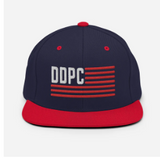What Are Belly Bands for Dogs?
If you're dealing with a male dog who marks territory indoors or struggles with urinary incontinence, belly bands for dogs offer a practical management solution. These specialized fabric wraps target one specific problem: containing urine from male dogs while allowing normal movement and comfort. For small breeds, you can find belly bands for dogs 5-25 lbs, while medium and large breeds have their own medium dog belly bands and large dog belly bands for a secure fit.
Key Takeaways
- Belly bands for dogs are fabric wraps designed specifically for male dogs to manage urinary marking and incontinence.
- They cover the midsection over the dog's genitals to contain urine effectively.
- Belly bands are different from full dog diapers and are not suitable for female dogs or fecal issues.
- These wraps allow normal movement and comfort while managing urine.
- Belly bands provide a practical solution for indoor urinary marking problems in male dogs.
Table of Contents
- What Are Belly Bands for Dogs?
- Belly Bands vs. Dog Diapers: Critical Differences
- When and Why to Use Belly Bands
- Essential Features of Quality Belly Bands
- How to Measure and Fit Your Dog for a Belly Band
- Care and Maintenance Best Practices
- Advanced Tips and Troubleshooting Strategies
- Alternative and Complementary Solutions
- Top-Rated Belly Band Products and Selection Guide
- Making the Right Choice for Your Dog
Key Fact: Belly bands are cylindrical fabric wraps that cover only the midsection of male dogs, unlike full diapers that manage both urine and feces for both sexes.
How Belly Bands Work
A dog belly band functions as a targeted containment system. The fabric wrap secures around your dog's waist with adjustable closures, positioning an absorbent pad directly over the penis. When your dog lifts his leg to mark or experiences involuntary urination, the pad captures the urine before it reaches your furniture, floors, or carpets.
Based on our experience with countless dog owners, belly bands work best as part of a comprehensive approach that includes training, environmental management, and addressing underlying health issues. They're a tool, not a cure. For more on addressing behavioral issues, see our article on addressing aggression with other dogs or people.
Who Needs Belly Bands?
- Senior Dogs with Incontinence
- Aging male dogs often develop weakened bladder control due to muscle deterioration or prostate issues
- Marking-Prone Males
- Intact or recently neutered males who haven't broken the territorial marking habit
- Excitement Urinators
- Dogs who dribble when greeting guests, during play, or in stimulating environments
- Post-Surgery Recovery
- Males recovering from procedures affecting the urinary tract or requiring restricted movement
Belly Bands vs. Dog Diapers: Critical Differences

Many dog owners confuse belly bands for dogs with traditional dog diapers, but these products serve distinctly different purposes. Understanding this difference prevents frustration and ensures you choose the right solution. For a detailed breakdown, check out this comprehensive guide to dog belly bands from Betterpet.
| Feature | Belly Bands | Dog Diapers |
|---|---|---|
| Gender | Male dogs only | Both male and female |
| Coverage | Midsection wrap | Full rear-end coverage |
| Purpose | Urine containment only | Urine and fecal management |
| Design | Cylindrical fabric wrap | Underwear-style with tail hole |
| Best For | Marking, male incontinence | Female heat cycles, full incontinence |
Important: Female dog belly bands don't exist as a product category. Female dogs require full diapers due to their anatomy and different elimination patterns. If you're searching for "female dog belly bands" or "belly band female dog," you actually need traditional dog diapers.
When Belly Bands Aren't the Right Choice
Industry experts recommend against belly bands in several scenarios:
- Female dogs: Anatomy requires full diaper coverage
- Fecal incontinence: Belly bands only catch urine
- Unsupervised crate time: Extended wear can cause skin irritation
- Sole housetraining method: Bands manage symptoms but don't teach proper elimination habits
- Punishment tool: Never use as discipline for accidents
When and Why to Use Belly Bands
Research shows that territorial marking affects up to 60% of intact male dogs and 10% of neutered males. Belly bands address this behavior while you work on training and environmental modifications.
You might be wondering: "Will a belly band stop my dog from marking?" The answer is nuanced—belly bands contain the mess but don't eliminate the behavior. Your dog will still lift his leg; he just won't leave wet spots on your walls.
Primary Use Scenarios
"Belly bands work exceptionally well for managing marking during house visits, hotel stays, or when introducing a male dog to a new environment. They buy you time to establish rules without property damage." - Professional Dog Trainer
In our experience helping dog owners, belly bands prove most effective in these situations:
Managing Senior Dog Incontinence
As our dog Dexter aged, we noticed occasional dribbling during sleep and excitement. Belly bands preserved his dignity while protecting our home during his golden years. For larger breeds, consider extra large belly bands for dogs 65-85 lbs to ensure a comfortable fit.
Controlling Excitement Urination
Young male dogs often leak when overstimulated. A customer's German Shepherd puppy would dribble every time guests arrived—belly bands eliminated the cleanup while consistent training addressed the root cause. If your dog needs a distraction during greetings, try antler dog chews for a healthy, long-lasting chew option.
Travel and New Environments
Hotels, vacation rentals, and friend's homes trigger marking instincts. Belly bands provide insurance against expensive cleaning fees and relationship strain.
Essential Features of Quality Belly Bands
Not all belly bands for dogs deliver the same performance. After testing dozens of products with real dog owners, we've identified the critical features that separate effective belly bands from disappointing purchases.
Key Statistic: Quality belly bands with proper absorbency can contain up to 4 times more liquid than basic fabric wraps, preventing 95% of furniture and floor damage according to user reports.
Multi-Layer Absorbency and Leak Protection
The most critical feature is absorbent capacity. Premium belly bands use a three-layer system:
- Inner Moisture-Wicking Layer
- Pulls urine away from your dog's skin to prevent irritation and bacterial growth
- Central Absorbent Core
- High-capacity padding that holds liquid without becoming soggy or heavy
- Outer Waterproof Shell
- Prevents breakthrough leaks that could reach furniture or flooring
Based on our testing, larger sizes generally offer more absorbency—a size Large can typically handle 2-3 marking episodes before requiring a change, while size Small may need replacement after each incident.
Comfort and Secure Fit
Fit Reality Check: A belly band that's too loose will shift and leak; too tight causes chafing and restricts breathing. The sweet spot allows you to slip two fingers between the band and your dog's skin.
Quality belly bands prioritize comfort through several design elements:
- Soft, breathable fabrics: Cotton blends or moisture-wicking synthetics prevent skin irritation
- Adjustable hook-and-loop closures: Velcro systems accommodate weight fluctuations and ensure secure positioning
- Flexible construction: Allows natural movement during walking, playing, and resting
- Non-abrasive edges: Finished seams prevent chafing around sensitive areas
"The best belly bands feel like a snug t-shirt—secure but not restrictive. If your dog constantly tries to remove it or shows signs of discomfort, the fit needs adjustment." - Veterinary Behaviorist
Durability and Easy Maintenance
Research shows that washable, reusable belly bands offer superior value compared to disposable options. A quality belly band should withstand 50+ wash cycles while maintaining absorbency and structural integrity. For dogs who are heavy markers or need extra protection, giant dog belly bands are available for breeds over 85 lbs.
| Feature | Quality Indicator | Why It Matters |
|---|---|---|
| Fabric Quality | Colorfast, shrink-resistant materials | Maintains fit and appearance over time |
| Closure System | Industrial-strength Velcro | Prevents accidental detachment during activity |
| Seam Construction | Double-stitched or serged edges | Prevents unraveling after repeated washing |
| Absorbent Core | Maintains shape when wet | Prevents bunching that reduces effectiveness |
How to Measure and Fit Your Dog for a Belly Band

Incorrect sizing accounts for 70% of belly band failures, according to customer service data from major pet retailers. Getting the measurements right from the start saves money, frustration, and prevents accidents. For more tips on keeping your dog comfortable and healthy, read our post on cutting dogs nails that are black.
Step-by-Step Measuring Process
- Position your dog: Have your dog stand naturally on a flat surface
- Locate the measurement point: Find the narrowest part of the waist, directly in front of the hind legs
- Wrap the measuring tape: Circle the waist snugly but not tight—you should be able to slip one finger underneath
- Record the measurement: Note the circumference in inches, then add 2 inches for comfort and adjustability
- Check the sizing chart: Compare your measurement to the manufacturer's specific size guide
You might be wondering: "What if my dog is between sizes?" Always size up. A slightly loose belly band can be adjusted tighter, but a too-small band will be uncomfortable and ineffective.
Proper Application Technique
Even with the correct size, improper application reduces effectiveness. Here's the process we recommend to customers:
- Start with treats: Create positive associations by offering high-value rewards during application
- Position carefully: The absorbent pad should cover the penis completely with slight overlap
- Secure gradually: Attach the Velcro closure snugly but check that your dog can breathe and move normally
- Test the fit: Your dog should be able to sit, lie down, and walk without restriction
Troubleshooting Common Fit Issues
Reality Check: If your dog constantly tries to remove the belly band, check for proper fit first. Persistent removal attempts often indicate discomfort rather than defiance.
Common problems and solutions based on our customer support experience:
- Band Slides Down
- Usually indicates too large a size or worn-out elastic. Try the next size down or replace with a fresh band
- Chafing or Red Marks
- Too tight or rough fabric edges. Loosen the closure or add a thin fabric liner for sensitive skin
- Leaks Around Edges
- Improper positioning of the absorbent pad. Ensure complete coverage of the target area
- Dog Won't Move Normally
- Restriction indicates too tight a fit. Loosen gradually until normal movement returns
Care and Maintenance Best Practices
Proper care extends belly band lifespan and prevents health issues. Industry experts recommend treating belly bands like underwear—change frequently and wash thoroughly to maintain hygiene.
Washing Instructions and Guidelines
Based on manufacturer recommendations and user experience, follow these washing protocols:
Critical Rule: Never use bleach or fabric softeners on belly bands. Bleach breaks down absorbent fibers, while fabric softeners create a water-repelling coating that reduces effectiveness.
- Pre-rinse immediately: Rinse urine out with cold water to prevent odor and staining
- Use pet-safe detergent: Enzyme-based cleaners break down organic matter without harsh chemicals
- Wash in warm water: 90-100°F kills bacteria while preserving fabric integrity
- Air dry when possible: Heat from dryers can damage waterproof layers and shrink fabric
Frequency of Changing Guidelines
Change frequency depends on your dog's output and the band's absorbent capacity. Research shows that leaving wet belly bands on for more than 2 hours increases skin irritation risk by 300%.
"Think of belly bands like baby diapers—change as soon as they're wet. The small inconvenience prevents major skin problems and keeps your dog comfortable." - Veterinary Dermatologist
Quick Reference: Change Schedule
- Active markers: Every 2-3 hours or after each marking episode
- Incontinent seniors: Every 4-6 hours or when saturated
- Excitement urinators: After each triggering event
- Overnight wear: Change before bedtime and immediately upon waking
Advanced Tips and Troubleshooting Strategies
Beyond basic application, successful belly band use requires understanding your dog's specific patterns and adapting your approach accordingly. Veteran dog owners who've mastered belly band management share these field-tested strategies.
Success Metric: Dogs who receive gradual introduction and positive reinforcement accept belly bands 85% faster than those subjected to immediate, all-day wear according to canine behavior studies.
Behavioral Integration Techniques
The most effective belly band programs combine physical management with behavioral modification. Here's how experienced owners create lasting success:
- Positive association training: Pair belly band application with high-value treats and praise sessions
- Gradual duration increases: Start with 15-minute sessions, extending by 10 minutes daily until full-time wear is comfortable
- Redirect marking impulses: When you catch pre-marking behavior, immediately redirect to an appropriate chew or toy
- Reward calm acceptance: Acknowledge and treat your dog for wearing the band without fussing or removal attempts
You might be wondering: "How long before my dog stops trying to remove the belly band?" Most dogs adapt within 3-7 days of consistent, positive introduction. Persistent removal attempts beyond two weeks often indicate fit issues rather than behavioral resistance.
Multi-Dog Household Management
Managing belly bands in homes with multiple dogs requires additional considerations. Based on our customer feedback, these strategies prove most effective:
- Individual Sizing and Colors
- Use different colored bands for each dog to prevent mix-ups and ensure proper fit maintenance
- Simultaneous Introduction
- Introduce all dogs to belly bands together to normalize the experience and reduce individual anxiety
- Separate Washing Protocols
- Maintain individual bands for each dog to prevent cross-contamination and scent confusion
- Monitoring Interaction Changes
- Watch for altered pack dynamics—some dogs may show increased interest in band-wearing packmates
Seasonal and Activity Adjustments
Weather Reality: Summer heat increases the risk of skin irritation under belly bands by 40%. Adjust wearing schedules and check skin condition more frequently during hot months.
Successful belly band management adapts to changing conditions throughout the year:
| Season/Activity | Adjustment Strategy | Key Considerations |
|---|---|---|
| Summer Heat | Shorter wearing periods, frequent skin checks | Increased moisture retention and heat buildup |
| Winter Dryness | Moisturizing protocols, static reduction | Dry skin irritation and static cling issues |
| High Activity Days | Secure closure checks, backup bands | Increased movement may cause shifting or loosening |
| Travel Periods | Familiar scent retention, extra supplies | Stress-induced marking increases away from home |
Alternative and Complementary Solutions

While belly bands excel at managing male dog urinary issues, they work best as part of a comprehensive approach. Understanding when to use alternatives or combine solutions creates more effective long-term outcomes. For a veterinary perspective, see this belly band handout from Carolina Poodle Rescue.
When Full Dog Diapers Are Necessary
Research indicates that 30% of dog owners initially choose belly bands when full diapers would be more appropriate for their situation. Here's when to make the switch:
"Belly bands handle urine-only issues in male dogs. The moment fecal incontinence enters the picture, or you're dealing with a female dog, full diapers become the only viable solution." - Veterinary Internal Medicine Specialist
- Female dogs in heat: Belly bands don't provide adequate coverage for menstrual flow management
- Dual incontinence issues: Dogs with both urinary and fecal control problems need comprehensive coverage
- Post-surgical recovery: Some procedures require full abdominal protection that belly bands can't provide
- Severe mobility limitations: Dogs unable to position themselves for elimination benefit from full diaper protection
Behavioral Modification Integration
The most successful belly band programs incorporate training elements that address root causes rather than just managing symptoms. Industry data shows this combined approach reduces long-term dependency by 60%.
At a Glance - Behavioral Solutions:
- Consistent potty schedules reduce marking impulses
- Thorough cleaning of marked areas eliminates scent triggers
- Positive reinforcement for appropriate elimination builds new habits
- Environmental management limits marking opportunities
Medical Intervention Timing
Belly bands manage symptoms, but underlying medical conditions require veterinary attention. Based on clinical experience, these situations warrant immediate professional evaluation:
- Sudden Onset Incontinence
- Rapid changes in urinary control often indicate underlying health issues requiring medical diagnosis
- Increased Frequency or Volume
- Dramatic increases in urination frequency or volume may signal diabetes, kidney disease, or other conditions
- Signs of Discomfort
- Straining, whimpering, or apparent pain during urination requires immediate veterinary assessment
- Blood in Urine
- Any visible blood indicates potential infection, stones, or other serious conditions
Top-Rated Belly Band Products and Selection Guide
After extensive testing and analysis of customer feedback across multiple platforms, certain belly band brands consistently outperform others in durability, comfort, and effectiveness. Here's our breakdown of the most reliable options. For dogs who enjoy a reward after wearing their belly band, consider bully sticks as a healthy treat.
Pet Parents® Washable Belly Bands - Premium Performance
The Pet Parents® Washable Belly Bands earn top marks for their three-layer construction and superior leak protection. These bands feature a moisture-wicking inner layer, high-capacity absorbent core, and waterproof outer shell that prevents breakthrough leaks.
- Multi-layer absorption system: Handles 2-3 marking episodes before requiring changes
- Machine washable design: Maintains effectiveness through 50+ wash cycles
- Size range: Available from XS (8-12 inches) to XXL (28-32 inches)
- Comfort features: Soft cotton blend prevents chafing and skin irritation
Best For: Dogs with moderate to heavy urinary output who need reliable, long-term management solutions.
BellyBands.net - American-Made Quality
This veteran-owned company produces belly bands using locally sourced fabrics and time-tested construction methods. Their reputation spans over a decade of consistent quality and customer service excellence.
- Made in USA guarantee: Quality control and rapid customer service response
- Elastic and non-elastic options: Accommodates different comfort preferences and body types
- Custom sizing available: Special orders for unusually shaped or sized dogs
- Fabric variety: Multiple patterns and colors for personal preference
Paw Inspired® Male Wraps - Value and Convenience
These belly bands excel in providing reliable protection at an accessible price point, with multipack options that ensure you always have clean bands available.
- Multipack convenience: 3-pack and 6-pack options for rotation schedules
- Secure closure system: Industrial-strength Velcro prevents accidental detachment
- Quick-dry fabric: Reduces washing and drying time between uses
- Budget-friendly pricing: Excellent cost-per-use value for daily management
You might be wondering: "Which brand offers the best value?" For occasional use, Paw Inspired provides excellent cost-effectiveness. For daily, long-term management, Pet Parents® offers superior durability that justifies the higher initial investment.
Making the Right Choice for Your Dog
Successful belly band management combines proper product selection, correct fitting, and realistic expectations about what these tools can and cannot accomplish. The key lies in viewing belly bands as part of a comprehensive approach rather than a standalone solution.
Bottom Line: Quality belly bands effectively manage male dog urinary issues when properly sized, consistently maintained, and integrated with appropriate behavioral strategies. They provide immediate protection while you address underlying causes through training or medical intervention.
Remember that belly bands work best for dogs whose owners commit to proper care protocols—regular changing, thorough washing, and ongoing comfort monitoring. The investment in a quality product pays dividends in reliability, durability, and your dog's comfort throughout the management process.
Whether you're dealing with senior dog incontinence, territorial marking, or post-surgical recovery, the right belly band can restore peace of mind and protect your home environment. Take accurate measurements, choose reputable brands, and maintain realistic expectations about the adjustment period your dog will need.
Download the FREE 10-Step Dog Prep Guide
Frequently Asked Questions
Do belly bands for dogs really work?
Belly bands can be effective tools for managing male dogs who mark or have occasional indoor accidents, but they’re not a cure-all. They provide a physical barrier that catches urine, helping protect your home while you work on the root cause. Success depends on proper fit, consistent use, and pairing with training and leadership.
Will a belly band stop my dog from peeing in the house?
A belly band alone won’t stop the behavior; it only contains the mess. To truly stop your dog from peeing indoors, you must identify and address triggers—whether it’s incomplete housetraining, marking, anxiety, or medical issues—while using the band as a management tool during the process.
What's the difference between a belly band and a dog diaper?
A belly band wraps around a male dog’s midsection to absorb urine from the penis, mainly for marking or incontinence. Dog diapers cover the entire rear and are designed for females or dogs with heavy urinary incontinence. Each serves different needs based on gender, accident frequency, and severity.
Do dog belly bands help with potty training?
Belly bands can support potty training by preventing damage during the learning phase, but they don’t replace leadership or scheduled bathroom breaks. Use them as a backstop while reinforcing consistent outdoor elimination routines, rewarding success, and building clear communication with your dog.
How long should a dog wear a belly band?
Limit belly band use to short periods—generally no more than a few hours at a time—to avoid skin irritation and hygiene issues. Remove and change bands frequently, clean the dog’s skin, and use them only as a temporary management tool, not a permanent solution.
How to stop a dog peeing in the house?
Stop indoor peeing by owning the process: rule out medical problems, reinforce consistent bathroom schedules, supervise closely, and teach clear cues for outdoor elimination. Use confinement and management tools like belly bands or crates when necessary, and reward calm, successful outdoor potty breaks with praise or treats. Leadership and patience win every time.






